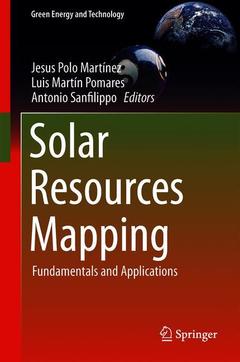Solar Resources Mapping, 1st ed. 2019 Fundamentals and Applications Green Energy and Technology Series

Details the mapping of solar resources at regional and country scales
Provides new methods and tools for assessing solar energy resources and mapping them geographically
Explains the fundamentals of social resource mapping, modern techniques and explaining how they may be used in decision-making
Date de parution : 01-2019
Ouvrage de 367 p.
15.5x23.5 cm
Thèmes de Solar Resources Mapping :
Mots-clés :
Solar Radiation Measurements; Solar Radiation Modeling; Solar Radiation Mapping; Solar Power Plant Simulation; Site Adaptation of Ground Measurements and Modeled Data; Solar Mapping; Solar Monitoring Stations; Solar Resource Assessment; Environmental Geography; natural resources and energy economics
Ces ouvrages sont susceptibles de vous intéresser

Solar Energy at Urban Scale 196,65 €


